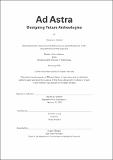Ad Astra : designing future archeologies
Author(s)
Kobald, Alexander(Alexander Vincent)
Download1102595544-MIT.pdf (27.96Mb)
Alternative title
Designing future archeologies
Other Contributors
Massachusetts Institute of Technology. Department of Architecture.
Advisor
Jennifer Leung.
Terms of use
Metadata
Show full item recordAbstract
This thesis proposes a methodology for the speculation of futures in architecture. The title "Ad Astra" translates as "to the stars", a romantic harkening to the human ambition and desire to interrogate and surpass the physical and intellectual boundaries of our world. The subtitle, "Designing Future Archaeologies" alludes to a method of producing these futures and the design knowledge available in them. This architecture is a story. It takes place aboard a spaceship carrying 800 passengers travelling for 800 years to the Trappist 1 system. This story is told through a narrative, describing a fictional history of a speculated future. The narrative is driven by three contrived events; pressure points that propel the plot of the story of the Theseus II; a ship/architecture that remakes itself from within in response to the changing social priorities and characters of its inhabitants. This architecture is an imagined future, born from the contingencies, variabilities and randomness of its speculated history. This future is designed; a future that seeks to produce knowledge even in an isolated time capsule of humanity in which "knowledge" is expected to atrophy. The knowledge produced aboard the Theseus II comes from within its isolated condition. Each of the scenarios has a speculated physical response, a disturbance to the status quo that is formed by the shifting material, social and epistemological priorities of the crew. Ultimately, this future is one of many possible futures; each the consequence of accumulated events whose physical and social consequences cannot be predicted. It is in this landscape of instability and randomness that there is a knowledge available to architecture and it is type of knowledge that will be necessary to design futures beyond human lifespans. The future is, fundamentally, contingent.
Description
This electronic version was submitted by the student author. The certified thesis is available in the Institute Archives and Special Collections. Thesis: M. Arch., Massachusetts Institute of Technology, Department of Architecture, 2019 Cataloged from student-submitted PDF version of thesis. Includes bibliographical references (pages 116-118).
Date issued
2019Department
Massachusetts Institute of Technology. Department of ArchitecturePublisher
Massachusetts Institute of Technology
Keywords
Architecture.